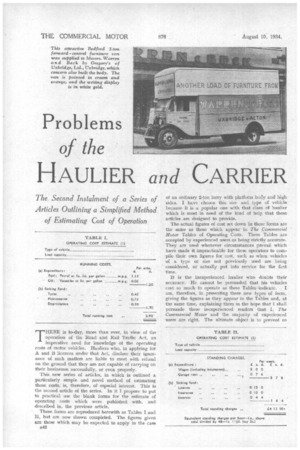Problems of the
Page 52

Page 53

If you've noticed an error in this article please click here to report it so we can fix it.
HAULIER and CARRIER
The Second Instalment of a Series of Articles Outlining a Simplified Method of Estimating Cost of Operation
THERE is to-day, more than ever, in view of the operation of the Road and Rail Traffic Act, an
• imperative need for knowledge of the operating costs of motor vehicles. Hauliers who, in applying for A and B licences under that Act, disclose their ignorance of such matters are liable to meet with refusal on the ground that they are not capable of carrying on their businesses successfully, or even properly.
This new series of articles, in which is outlined a particularly simple and novel method of estimating those costs, is, therefore, of especial interest. This is the second article of the series. In it I propose to put to practical use the blank forms for the estimate of operating costs which were published with, and described in, the previous article.
Those forms are reproduced herewith as Tables Land H, but are now shown completed. The figures given are those which may be expected to apply in the case B42 of an ordinary 2-ton lorry with platform body and high 'sides. I have chosen this size and type of vehicle because it is a popular one with that class of haulier which is most in need of the kind of help that these articles are designed to provide.
The actual figures of cost set down in these forms are the same as those which appear in The Commercial Motor Tables of Operating Costs. These Tables are accepted by experienced users as being strictly accurate. They are used whenever circumstances prevail which have made it impracticable for these operators to compile their own figures for cost, such as when vehicles of , a type or size not previously used are being considered, or actually put into service for the first time.
It is the inexperienced haulier who doubts their accuracy. He cannot be persuaded that his vehicles cost so much to operate as these Tables indicate. I am, therefore, in presenting these new types of form, giving the figures as they appear in the Tables and, at the same time, explaining them in the hope that I shall persuade these inexperienced readers that I, The Commercial Motor and the majority of experienced users are right. The ultimate object is to prevent so much of that price-cutting which is the outcome of under-estimation of operating costs.
I am assuming that this 2-tonner has cost, new, £230 complete with tyres, and that a set of tyres costs £30, so that the net capital value of the lorry is £200. The cost of the tyres is deducted, because, in making an estimate of cost of operation, or in compiling figures for such cost, there is a separate item for tyres.
Dealing first with Table I, the running cost, the first item is petrol. A reasonable estimate for the mileage per gallbn of a vehicle of this type is 13, and, dividing 13 into ls. 3d., the price of a gallon of petrol, a figure of 1.15d. is reached for the cost per mile for fuel. That is set down in the appropriate place in the form.
Lubric\ating oil is consumed at the rate of 700-750 miles to the gallon. If the oil costs 3s. per gallon, then 720 m.p.g. is equivalent to 1-20th of a penny per mile for oil. That is 0.05d., as appears in the form.
Owners of new vehicles will be inclined to criticize the figure of 700-750 m.p.g. and to point out that they obtain much better results—perhaps twice as many miles to the gallon. To take the latter figure would be to overlook two factors of importance.
First of all, it is more than likely that they are overlooking the fact that every 2,000 or 3,000 miles it is recommended that the crankcase be emptied of oil and replenished. That may involve as much as l gallon, sometimes more, being put into the crankcase at once.
If I take 3,000 mile:, an outside figure, especially with the cheaper grade of oil which I am assuming to be used—in that period there will have been used two gallons for day-to-day replenishment (equivalent to 1,500 m.p.g.), plus 14 gallon for refilling the crankcase sump when the change of oil is made. That is a total of 34 gallons in 3,000 miles, which is about 860 m.p.g. The other factor is the gradually increasing consumption of oil which is always experienced as a vehicle grows older.
At any rate, if the reader keeps in mind these two factors he will not be inclined to criticize the figure of 720 m.p.g. which I have taken and which The Commercial Motor Tables of Operating Costs confirm.
These two figures of cost are, in this scheme that I have in mind, the least important, for, despite all that I have stated about misunderstandings concerning oil consumption, even the most inexperienced haulier cannot overlook them. The slight error that he can make in under-estimating his oil consumption in the early months of the life of his vehicle is not going to make much difference.
In Table I these two items are referred to as " (a) Expenditure" and the total is 1.20d per mile. There are eight other items of the total operating cost. They are set down in the forms, but their explanation and discussion will have to be deferred to a subsequent article. S.T.R.




















































































